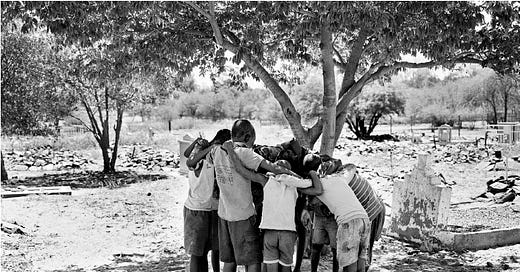No fewer than eight boys are huddled together. They are under a patch of shade. Since most of their heads are bowed, there is an illusion in the placement of the tree that its trunks have emerged from their bodies. The shade in which they stand, in fact, and as far as the eye can see, is the largest shade in the area. Perhaps this is the reason they have chosen it for their pre-game prayer. That cool of solemnity. The dead are here. You notice it slowly, but after a while it is all there is to this place. The graves. Some are heaps of rock. A stick juts out in place of a headstone. It is a still afternoon. The boys have gathered under a mortal light.
— Emmanuel Iduma
“The question for me is always, who does this picture serve?”
After completing Terreno Ocupado and As Terras do Fim do Mundo, it was clear that I needed to consider ways in which the mobilisation of the war in Angola and its aftermath could be located within South Africa’s borders. I had an idea of a militarised landscape, but rather than spaces connected with the usual apparatus of the South African Defence Force (SADF), I wanted to look at sites that, once civilian, were harnessed by the military during the war and afterwards.
I identified four places: Pomfret, Schmidtsdrift, Platfontein, and Riemvasmaak. Beyond their military connection, these places shared histories of violence and dispossession during the colonial and apartheid eras, and more recently, since our new democracy in 1994, restitution and redress.
Photographing for The Borderlands was challenging and confronting. Since the 1980s I have sidestepped the issue of photographing people. Even in personal situations where the relationship is clear and unambiguous, I am ambivalent. I remember attempting to photograph people in the early 1980s; it was seldom a comfortable or satisfactory experience – on either side of the camera. The question for me is always, who does this picture serve? It’s hard to reconcile the act of taking someone’s portrait it it’s not a mutually beneficial and equal exchange. And in most contexts, it isn’t. But in Riemvasmaak, Pomfret, Schmidtsdrift, and Platfontein, I was forced to confront my resistance because to avoid photographing people would mean to evacuate them from their homes and their land once again. In these places, people are re-establishing communities that have been broken for decades, making new lives and forging new identities for themselves. I needed to acknowledge that.
— Jo Ractliffe
About Jo Ractliffe
Ractliffe was born in 1961 in Cape Town and lives there. Her photo-books include Being There (2022), Photographs: 1980s – Now (2020), Signs of Life (2019), Everything is Everything (2017), The Borderlands (2015), As Terras do Fim do Mundo (2010) and Terreno Ocupado (2008). She was one of four artists shortlisted for the Deutsche Börse Photography Foundation Prize (2022) and was nominated for the Discovery Prize at the Rencontres d'Arles photography festival (2011). Learn about her work here.
LAST WEEK — “Students in Ngombe” by Sana Ginwalla
There is something about the shadows in this photograph that make the composition come alive. I wanted to decontextualise the photograph from the school grounds, with minimal natural elements to hold the students into the frame – stones, shadows and sky. The harsh shadows on brick become gentle on the grey ground, politely stopping at the bare feet of the students. The posture and anonymity of the students is also what further dignifies the image – they are looking outward into their future.
ANNOUNCING OUR EDITORIAL FELLOWS: Congratulations to Onotu David, moshood, Sana Ginwalla, Sibongakonke Mama, and Zenas Ubere. Beginning with the January 17, 2024 issue of the newsletter, the Fellows will initiate and facilitate correspondence with the featured photographers, write short narrative captions, and prepare the newsletter for publication.
This is the 100th edition of this publication, which also read on web (best for viewing images), and via the Substack iOS/Android apps.
TENDER PHOTO is a newsletter on African photography. Every Wednesday we feature a photograph and a short caption about it, and include a statement from the photographer. Every Friday, we publish commentaries or photo-essays in response to photographs previously featured on the newsletter. The most recent series is INDEX. Please note that there would be no Friday edition until January 26.
Our goal is to work with African photographers by creating a platform in which they lead the cataloguing and engagement with their work.
Thank you for reading. If this newsletter was shared with you, consider subscribing, or forward to a friend. Please whitelist the newsletter to ensure you never miss it.






Happy 100th! Wonderful edition as usual!